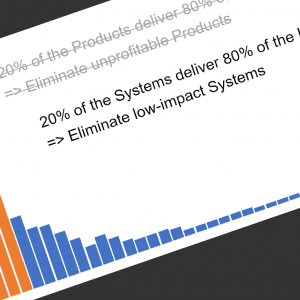Okay – to be fair, that really wasn’t the end of the chargebacks conversation. One of my cohorts suggested that we each come up with an argument counter to our position; I needed to come up with something “good” about chargebacks.
Actually, it’s quite easy to come up with the one good thing; the only problem is that it’s something that most IT departments can’t take advantage of …
Transparency
Many business units, dissatisfied with the speed, efficiency, general business savvy (and lack thereof) of the IT Department, engage external consultants and roll their own systems (the so–called shadow IT problem in many companies). A chargebacks system actually empowers those business units to spend their money externally; if I can get an invoice from internal IT, I can get an invoice from an external vendor.
The wily IT Department could/should encourage behavior such as this – if only to force a decent analysis of total delivered cost.
For example; the simplest exercise might be to compare hourly rates, external consultant vs. internal employee. Have you ever figured out your hourly rate? To keep the math simple, we’ll take annual salary and divided by 2000 (40 hours per week times 50 weeks per year). Actually, let’s be apply a 30% benefits load, to get a better picture of total cost to the company. Again, to keep the math simple – let’s say you make $100,000 per year. ($100K/year * 1.3) / 2K hrs/year = $65 bucks an hour.
$65/hour – just try to find folks skilled at ERP implementations, DBA/data warehouse, high availability data center architecture, and/or any other sufficiently specialized vertical technology at that hourly rate … if you can, and you’re near Chicago, please give me a call!
The numbers work for any area of the country; if your high-powered consultants are less than $100 an hour, then your annual salaries probably ratchet down as well. There’s also a minor flaw in my over-simplifications … relatively few hard-working IT employees only work 40 hours a week!
No wonder that internal IT folks, once clued in to this apparent inequity, long to give up their corporate job and hang out a shingle of their own.
Internal IT has a huge cost advantage.
The Other Shoe
Unfortunately this isn’t always the whole story. An open market is accompanied by marketing, and consulting firms are typically much better than internal IT at putting forward a concise, relevant, benefits-focused message to justify their cost. The cynical call this salesmanship, but the enlightened see this as highly evolved communication skills.
And this is where the enlightened IT department needs to focus their attention – we must make sure that the message [the project proposal] is accurate and complete. Don’t stop at the hourly rate comparison; internal IT …
- … is already familiar with the subject matter (the what). This means a dramatically shorter learning curve, and a much better time-to-value
- … is already familiar with the domain experts (the who). We know who to talk to, where the skeletons are buried, and where the biggest change management challenges and opportunities are lurking. Again, much better time-to-value …
- … is better at laying out a complete cost picture (the how) … hardware/software, depreciation, disaster recovery, redundancy / high availability, plus integration with existing technical architectures, authentication schemes, compliance processes and policies …
Unfortunately, this is where most IT departments fumble the ball. And it’s not just the pre-sales communication; consulting firms [that last more than a few years] also know how to manage the communication with their paying customers … so they remain paying customers.
Typically, internal IT folks that are good at this type of communication are also tempted to print up some business cards and start moonlighting.
Internal IT has a huge marketing disadvantage.





Comments (0)